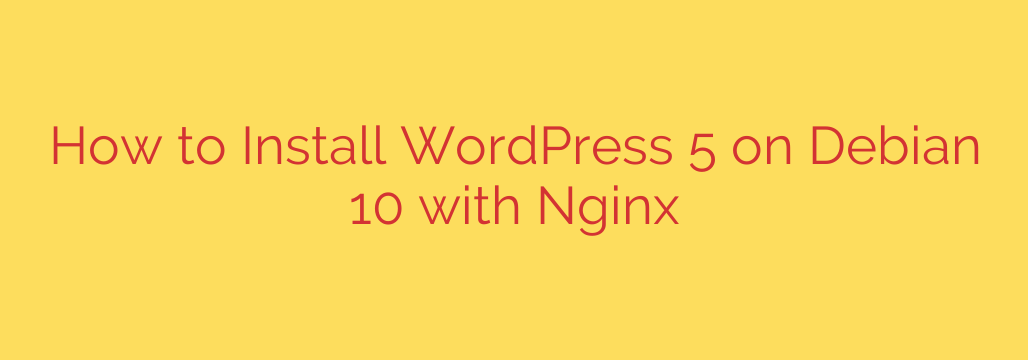
Setting up a robust and performant environment for your WordPress website is crucial for speed, security, and reliability. While many opt for Apache, pairing WordPress with Nginx on a stable distribution like Debian 10 offers significant advantages, particularly in handling static content and managing high traffic loads efficiently when combined with PHP-FPM.
This guide outlines the key steps to get your WordPress site up and running on this powerful stack.
Prerequisites: The Foundation
Before diving in, ensure you have a clean installation of Debian 10 and SSH access with root or sudo privileges. You’ll need to install the core components:
- Nginx: The high-performance web server.
- PHP-FPM: The FastCGI Process Manager for PHP, essential for Nginx to process PHP code.
- MariaDB or MySQL: The database server to store WordPress data.
Use your package manager (apt) to install these packages. It’s also wise to keep your system updated by running sudo apt update && sudo apt upgrade.
Setting Up the Database
WordPress requires a database to store all its content, user information, and settings. You’ll need to:
- Log in to your MariaDB/MySQL server.
- Create a new database specifically for your WordPress installation. Choose a descriptive name.
- Create a new database user and assign a strong, unique password to this user. Avoid using the root database user for WordPress.
- Grant this new user full privileges on the database you just created.
Remember to secure your database installation during or immediately after the initial setup.
Configuring Nginx for WordPress
Nginx needs to be configured to serve your website files and correctly pass PHP requests to PHP-FPM. This is typically done by creating a server block configuration file within the Nginx configuration directory (e.g., /etc/nginx/sites-available/your_domain.conf).
Key directives in your Nginx configuration include:
server_name: Your domain name(s).root: The directory where your WordPress files will reside.index: Define the default files Nginx should look for (e.g.,index.php,index.html).location /: Directives for handling URL requests.location ~ \.php$: This is crucial for passing.phpfiles to the PHP-FPM socket or address.
You’ll need to enable the new server block by creating a symbolic link from sites-available to sites-enabled, then test the Nginx configuration (sudo nginx -t) and reload Nginx (sudo systemctl reload nginx).
Downloading and Installing WordPress Files
Now it’s time for WordPress itself:
- Download the latest version of WordPress from the official WordPress.org website using
wget. - Extract the downloaded archive into the web root directory you defined in your Nginx configuration.
- Copy or rename
wp-config-sample.phptowp-config.php. - Edit
wp-config.phpto input the database name, username, and password you created earlier.
Setting File Permissions
Incorrect file permissions are a common source of errors and security vulnerabilities. Set appropriate ownership and permissions for your WordPress files and directories. Typically, the web server user (often www-data) needs ownership or write permissions on certain directories like wp-content to allow theme and plugin installations/updates.
Completing the WordPress Installation via Web Browser
With the files in place and Nginx configured, you can finalize the setup:
- Open your web browser and navigate to your domain name or server’s IP address.
- The standard WordPress installation wizard should appear.
- Follow the on-screen prompts to complete the installation, setting your site title, admin username, password (choose a very strong password!), and email address.
Post-Installation and Security Tips
Congratulations, WordPress is installed! However, the work isn’t quite finished. For a secure and efficient site:
- Always keep WordPress, themes, and plugins updated.
- Implement an SSL certificate (HTTPS) for encrypted connections. Let’s Encrypt offers free certificates.
- Secure your admin area by using strong, unique passwords and potentially limiting access.
- Consider installing a security plugin to help mitigate threats.
- Regularly back up your database and files.
- Tune PHP-FPM settings for better performance based on your server’s resources.
By following these steps, you build a fast, stable, and secure foundation for your WordPress website on Debian 10 with Nginx and PHP-FPM. This setup provides excellent control and performance compared to many shared hosting environments.
Source: https://kifarunix.com/install-wordpress-5-with-nginx-on-debian-10-buster/








